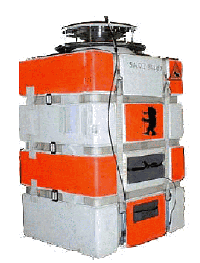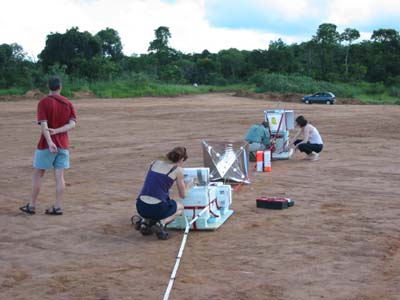Purpose of the flight and payload description
SAOZ stands for Systeme d'Analyse par Observation Zenithale and is a UV-visible spectrometer able to provide vertical profiles of O3, NO2, OClO, BrO and H2O by solar occultation during ascent of the balloon (or descent) and from float at 30 km during sunset (or sunrise). The balloon version of the SAOZ instrument is very similar to the one used for ground-based measurements of total ozone and NO2.
It is composed by a commercial flat field, 360mm, holographic grating spectrometer equipped with a 1024-diode linear array and an entrance slit of 50 µm. A simple conical mirror replaces the gondola orientation or sun tracker systems generally used on large balloon platforms and is driven by an on-board computer, connected to a PTU (Pressure, Temperature and Humidity) sensor, a GPS (Global Positioning system ) for the localisation (Altitude, latitude and longitude) and an Argos transmitter for the recovery of the payload after cut-down and descent under parachute.
At left can be seen a picture of the standard package.The weight of the instrument is 20 Kg and is contained in a insulated box with only a small aperture in the top for capture the solar rays. It's currently flown in three configurations, SaOZ-Standard, SAOZ-BrO and SAOZ-H2O each tuned to a different wavelength for measurements of different atmospheric constituents.
The second payload on the balloon was an instrument called DIRAC which stands for Determination In situ by Rapid Analytical Chromatography. It's a portable, lightweight gas chromatograph aimed to perform fast analysis of a single tracer to maximize the vertical resolution of ascent/descent profiles. It was developed by the University of Cambridge based on the techniques used in another instrument called DESCARTES. The sample in DIRAC is collected on a Carboxen trap by passing through it a known volume of air. The use of the carbon based Carboxen adsorbent enables a wide range of halocarbons to be pre-concentrated prior to analysis, thus extending the potential range of measured species. DIRAC has a maximum autonomy of 10 hours and works automatically using a PC-104 embedded computer. Data is stored on board and can also be transmitted to ground via a telemetry link. It's overall weight is 21 kg.
Finally were also on board an O3 sonde and an H2O (water vapour) sensors.
Details of the balloon flight
Balloon launched on: 2/18/2003 at A
Launch site: Meteorological Research Institute, Baurú, Sao Paulo, Brazil
Balloon launched by: Centre National d'Etudes Spatiales (CNES) / GLB
Balloon manufacturer/size/composition: Zero Pressure Balloon model 10zl 10.000 m3
End of flight (L for landing time, W for last contact, otherwise termination time): 2/18/2003
External references
- HIBISCUS campaign web site Laboratoire Atmosphères, Milieux, Observations Spatiales LATMOS
- SAOZ balloon profiles for the validation of OSIRIS, SCIAMACHY and GOMOS at various latitudes 17th ESA Symposium on European Rocket and Balloon Programmes and Related Research, 30 May - 2 June 2005, Sandefjord, Norway
- Technical Note: Validation of Odin/SMR limb observations of ozone, comparisons with OSIRIS, POAM III, ground-based and balloon-borne instruments Atmos. Chem. Phys., 8, 3385-3409, 2008
- The Validation of the Envisat Chemistry Instruments by Use of Stratospheric Balloons and Aircraft ENVISAT Validation Workshop (ESA SP-531). 9-13 December, Frascati, Italy
218If you consider this website interesting or useful, you can help me to keep it up and running with a small donation to cover the operational costs. Just the equivalent of the price of a cup of coffee helps a lot.



